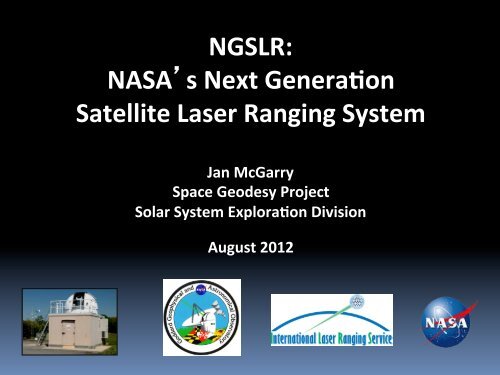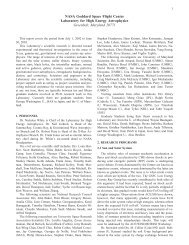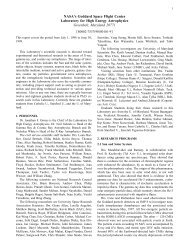You also want an ePaper? Increase the reach of your titles
YUMPU automatically turns print PDFs into web optimized ePapers that Google loves.
<strong>NGSLR</strong>:<br />
<strong>NASA</strong>’s Next Genera0on<br />
Satellite Laser Ranging System<br />
Jan McGarry<br />
Space Geodesy Project<br />
Solar System Explora0on Division<br />
August 2012
Satellite Laser Ranging Technique<br />
Observable: The precise measurement of the roundtrip time-of-flight of an ultrashort (< 500 psec)<br />
laser pulse between an SLR ground station and a retroreflector- equipped satellite which is then<br />
corrected for atmospheric refraction using ground-based meteorological sensors.<br />
• Unambiguous time-of-flight<br />
measurement<br />
• 1 to 2 mm normal point precision<br />
• Passive space segment (reflector)<br />
• Simple refraction model<br />
• Night / Day Operation<br />
• Near real-time global data<br />
availability<br />
• Satellite altitudes from 300 km to<br />
22,000 km (GPS, GLONASS) and<br />
the Moon<br />
• Centimeter accuracy satellite<br />
orbits<br />
~ 1-2 cm (LAGEOS) & ~2-3 cm (GPS)<br />
SLR generates unambiguous centimeter accuracy orbits!<br />
2
Retro-Reflector Array (RRA): GPS 35,36<br />
32 solid cubes – each 28mm<br />
Aluminum coated reflective surfaces<br />
Array shape: planar square<br />
Array size: 239 x 194 x 37 mm<br />
Array mass: 1.27 kg<br />
Hollow corner cube<br />
Corner Cube Reflectors<br />
and Arrays<br />
Retro-Reflector Array (RRA):<br />
ICESat, JASON, GFO, ADEOS-II<br />
9 solid cubes – each 32 mm<br />
Research grade radiation resistant suprasil quartz<br />
Silver coated<br />
Array shape: hemispherical (16cm diameter)<br />
Array mass: 731 gm<br />
<strong>NGSLR</strong> 8/22/2012 jlfm<br />
3
Space Missions Tracked by SLR<br />
~70 satellites tracked<br />
since 1964<br />
<strong>NGSLR</strong> 8/22/2012 jlfm<br />
4
International Laser Ranging Service (ILRS)<br />
<strong>NGSLR</strong> 8/22/2012 jlfm 5
Lunar Laser Ranging (LLR) to retro-reflectors<br />
• There are 5 retro-reflectors arrays: 3 Apollo<br />
and 2 Luna.<br />
• Apollo RRA’s have 3.8 cm cubes. Apollo 11<br />
& 14 have 100, Apollo 15 has 300.<br />
• Regularly tracked by only a few stations.<br />
<strong>NASA</strong> funded University of Texas (MLRS) has<br />
successfully ranged continuously since 1970s.<br />
Ranges are accurate to a few centimeters.<br />
<strong>NGSLR</strong> 8/22/2012 jlfm 6
GSFC records first SLR returns ever on Oct 31, 1964<br />
(GSFC team lead by Henry Plotkin)<br />
GODDARD LASER (GODLAS)<br />
BE-B: first satellite with<br />
retro-reflectors<br />
<strong>NGSLR</strong> 8/22/2012 jlfm 7
Goddard Geophysical and Astronomical Observatory (GGAO)<br />
Photo circa 1980<br />
Located ~ 3 miles<br />
from GSFC in<br />
middle of BARC on<br />
Springfield Road.<br />
Currently one of<br />
only a few sites with<br />
all four Geodetic<br />
Techniques.<br />
GGAO has been<br />
the site of all <strong>NASA</strong><br />
SLR system<br />
development, testing<br />
and colocations. The<br />
Italian MLRO<br />
system, the Saudi<br />
SALRO, German<br />
MTLRS, the<br />
Japanese GUTS, and<br />
other ILRS systems<br />
have also been<br />
developed and tested<br />
at site.<br />
<strong>NGSLR</strong> 8/22/2012 jlfm 8
Current <strong>NASA</strong> SLR: MOBLAS-7<br />
- Systems built around in late<br />
1970s and still operating.<br />
- 76 cm (30”) diameter<br />
telescope.<br />
- Laser rep rate: 1,2,4,5,10Hz.<br />
- Wavelength & energy:<br />
532nm, 100mJ.<br />
- 5 systems, all still<br />
operating, now<br />
located in:<br />
California<br />
Australia<br />
South Africa<br />
Maryland (GGAO)<br />
Tahiti.<br />
<strong>NGSLR</strong> 8/22/2012 jlfm 9
The Next Genera0on SLR System<br />
<strong>NGSLR</strong> is a high repe//on rate single photon<br />
detec/on laser ranging system capable of tracking<br />
cube corner reflector (CCR) equipped satellites in<br />
Earth orbit. The concept of <strong>NGSLR</strong> was developed<br />
by J. Degnan (GSFC, re/red) in the 1990s. Technical<br />
development con/nues at Goddard. The system has<br />
demonstrated tracking of Earth orbit satellites with<br />
al/tudes from 300 km to 20000 km. Comple/on of<br />
the <strong>NGSLR</strong> prototype will occur during the Space<br />
Geodesy Project.<br />
Achievements & Status:<br />
OMC ranging plot of satellite returns<br />
ú� Successfully tracked most of ILRS satellites.<br />
ú� LEO, LAGEOS 1 & 2, and GNSS have all<br />
been successfully tracked in both daylight<br />
and night.<br />
ú� Preliminary intercomparison testing with<br />
MOBLAS-‐7 completed. Analysis ongoing.<br />
ú� Installing new optical bench to support use<br />
of 2.5 mJ, 2 kHz Photonics Industries laser<br />
and to provide required automation.<br />
System Features:<br />
ú� 1 to 2 arcsecond poin/ng/tracking accuracy<br />
ú� Track CCR equipped satellites to 20,000 km<br />
al/tude, 24/7 opera/on<br />
ú� Single photon detec/on<br />
ú� Semi automated tracking features<br />
ú� Increased accuracy & stability<br />
ú� Small, compact, low maintenance, increased<br />
reliability<br />
ú� Lower opera/ng/replica/on costs<br />
<strong>NGSLR</strong> 8/22/2012 jlfm<br />
10
1. Time & Frequency<br />
2. Telescope<br />
3. Transceiver Bench<br />
4. Laser<br />
5. Laser Hazard Reduc0on<br />
System (LHRS)<br />
Major Subsystems<br />
6. Tracking<br />
7. Receiver<br />
8. Computer and So[ware<br />
9. Weather<br />
10. Shelter and Dome<br />
<strong>NGSLR</strong> 8/22/2012 jlfm 11
<strong>NGSLR</strong> System Characteris0cs<br />
• Telescope:<br />
-‐ 40 cm Telescope Aperture Off-‐Axis Parabola<br />
-‐ No Central Obscura/on<br />
• Tracking:<br />
-‐ AZ/EL with 1 arcsec RMS gimbal poin/ng accuracy<br />
• Transceiver Bench:<br />
-‐ Common Op/cs for Transmit and Receive<br />
-‐ Passive Transmit/Receive Switch<br />
-‐ Risley Prism Point-‐Ahead of Transmit<br />
• Laser (new):<br />
-‐ 50 ps pulsewidth, 2 kHz PRF, 3 mJ/pulse<br />
-‐ Asynchronous PRF, soaware controlled<br />
-‐ Divergence control by soaware<br />
• Receiver:<br />
-‐ High QE, GaAsP Microchannel Plate Photomul/plier<br />
-‐ Constant Frac/on Discriminators<br />
-‐ GPS-‐synchronized Rubidium Oscillator /Time and<br />
Frequency Receiver<br />
-‐ Picosecond Precision Event Timer<br />
• Weather:<br />
-‐ Day/Night All-‐Sky Cloud Sensor (thermal)<br />
-‐ Wind Monitor<br />
-‐ Surface Pressure, Temperature, and Humidity Monitors<br />
1'-0.73"<br />
-‐ Visibility/Precipita/on Sensor <strong>NGSLR</strong> 8/22/2012 jlfm<br />
47.02"<br />
34.00"<br />
12
New Technologies Developed for <strong>NGSLR</strong><br />
The requirements of SLR2000 (i.e. eye safety and unmanned opera0on) led to a<br />
number of unique computer-‐controlled hardware devices including:<br />
• Totally Passive Transmit/Receive Switch allows the full aperture of the telescope to be<br />
shared simultaneously , with minimal op/cal loss, by the transmieer and receiver<br />
independent of the laser repe//on rate and receive signal polariza/on.<br />
• Dual Risley Prism Device permits independent arcsecond accuracy poin/ng of the<br />
transmieer and receiver allowing smaller receiver fields-‐of view for reduced solar noise.<br />
• Variable Laser Trigger varies laser repe//on rate about the nominal 2 kHz to prevent<br />
backscaeer from the outgoing laser pulse from overlapping satellite returns at receiver.<br />
• Smart Meteorological Sta0on monitors hemispherical cloud cover and ground<br />
visibility, precipita/on, wind speed and direc/on, while providing the usual atmospheric<br />
surface pressure, temperature, and rela/ve humidity measurements needed to support<br />
atmospheric refrac/on correc/ons to the range measurements.<br />
<strong>NGSLR</strong> 8/22/2012 jlfm<br />
13
Simplified Hardware Block<br />
Diagram<br />
This diagram shows the basic flow of signals<br />
within the system.<br />
Start<br />
Diode<br />
ICC Computer<br />
Servo Controller<br />
LRO Laser<br />
<strong>NASA</strong> mJ Laser<br />
<strong>NGSLR</strong> System Block Diagram<br />
Range gate:<br />
SLR 2 kHz<br />
LRO 28 Hz<br />
1 PPS<br />
2 kHz<br />
Fires<br />
Stop Events<br />
28 Hz Fire Time<br />
Adjusted 2 kHz<br />
Fire Time<br />
Returns<br />
Amplifier<br />
Returns<br />
Discriminator<br />
Event Timer<br />
Range Gate Generator<br />
I/O Chassis (HTSI)<br />
2 kHz & 1 PPS<br />
Laser Fire<br />
MCP PMT<br />
(Photek/Hammamatsu)<br />
28 Hz Laser Fire<br />
Window/Window<br />
MCP Window<br />
(Secondary)<br />
Cesium Clock<br />
(Symmetricom 4310)<br />
10 MHz &<br />
1 PPS<br />
2 kHz &<br />
1 PPS<br />
2kHz<br />
1 PPS<br />
Laser Fire<br />
10 MHz<br />
<strong>NGSLR</strong> 8/22/2012 jlfm<br />
OR<br />
10 MHz<br />
Distribution Amplifier<br />
(Symmetricom 6502)<br />
Computer Clock Sync<br />
Interface<br />
VME<br />
Chassis<br />
Dome<br />
Controller<br />
Risley<br />
Prisms<br />
10 MHz<br />
1 PPS Generator<br />
1 PPS<br />
2 kHz &<br />
1 PPS<br />
10 MHz<br />
GPS Time and Freq. Rcvr.<br />
10 MHz &<br />
1 PPS<br />
POP<br />
DAM<br />
(Primary)<br />
Maser<br />
10 MHz<br />
MOBLAS 7<br />
Used for synchronized<br />
LRO tracking<br />
GPS Time<br />
(hh:mm:ss)<br />
Weather<br />
Instruments<br />
MVP<br />
Controllers<br />
14
Automa0on Overview<br />
(some of the func0ons performed by the so[ware)<br />
• Obtaining input files:<br />
-‐ automa/cally pull predic/on and other data files from the server.<br />
• System scheduling:<br />
-‐ soaware completely determines/controls what is tracked and when.<br />
• Operator decision making:<br />
-‐ open/close dome based on weather,<br />
-‐ keep telescope from poin/ng into the sun,<br />
-‐ determine if we can track and where in the sky based on cloud cover.<br />
• Signal processing and closed-‐loop tracking:<br />
-‐ determine if system is higng the satellite,<br />
-‐ search for the satellite and op/mize the poin/ng.<br />
• Transmit / receive path op0cs configura0on and control:<br />
-‐ determine and control op/cal bench configura/on,<br />
-‐ decide configura/on based on target, day/night.<br />
• Data processing and product delivery: normal points delivered hourly.<br />
<strong>NGSLR</strong> 8/22/2012 jlfm 15
In-‐house built 2 kHz mJ laser<br />
Regenera/ve amplifier seeded by a gain-‐switched diode laser<br />
Nd:YAG slabs<br />
1.5m folded<br />
cavity<br />
Seeder<br />
D. Poulios and B.Coyle<br />
Used for intercomparison passes with MOB-‐7<br />
<strong>NGSLR</strong> 8/22/2012 jlfm<br />
KTP doubler<br />
Pockels cell<br />
~200 ps pulsewidth, ~1 mJ per pulse energy<br />
16
SATELLITE PASSES TRACKED BY <strong>NGSLR</strong> APRIL TO JUNE 2012<br />
SUBSET SELECTED FOR PRELIMINARY PERFORMANCE ANALYSIS<br />
SATELLITE # passes NIGHT # passes DAY<br />
GLONASS (GNSS) 5 1<br />
GALILEO (GNSS) 1 0<br />
ETALON (GNSS altitude) 1 0<br />
LAGEOS (1/2) 7 5<br />
LARES 4 1<br />
STARLETTE/STELLA 4 5<br />
Other LEO 17 6<br />
TOTAL 39 18<br />
Passes tracked with Coyle laser and Hamamatsu detector
3 mm normal points<br />
Daylight Ranging to GNSS<br />
Observed Minus Calculated (OMC)<br />
-‐ Green dots are returns.<br />
-‐ Blue dots are what SW flags<br />
as signal (prob(FA)
Final System Configura0on<br />
Hamamatsu High QE MCP PMT:<br />
• Model R5916U-‐64<br />
• GaAsP Photocathode<br />
• QE > 43%<br />
• Rise Time
New Op0cal Bench<br />
Reasons for new design:<br />
- Improved alignment capability<br />
-Space for automated controls<br />
- Improved isolation between Xmit/Rcv<br />
T/R switch Detector<br />
<strong>NGSLR</strong> 8/22/2012 jlfm<br />
Star Camera<br />
Xmit Path<br />
Rcv Path<br />
20
Op0cal Bench Development in B33 Clean-‐room: completed<br />
<strong>NGSLR</strong> 8/22/2012 jlfm 21
Automa0on Tes0ng at 1.2m Telescope Lab: close to complete<br />
<strong>NGSLR</strong> 8/22/2012 jlfm 22
SUMMARY<br />
-‐ GGAO is the birthplace of SLR. <strong>NASA</strong> has had an ac0ve SLR program at <strong>NASA</strong><br />
since the 1964.<br />
-‐ Current <strong>NASA</strong> sta0ons were built in the late 1970s and need to be replaced.<br />
-‐ One of the goals of the Space Geodesy Project is to get the prototype<br />
sta0ons completed and to demonstrate performance.<br />
-‐ The Next Genera0on SLR (<strong>NGSLR</strong>) has demonstrated tracking of LEO to GNSS<br />
day and night (from al0tudes of 300 km to 22000+ km).<br />
-‐ Preliminary tracking data being analyzed for performance.<br />
-‐ The automa0on and performance of <strong>NGSLR</strong> with new laser and op0cal bench<br />
will be demonstrated in the coming months.<br />
<strong>NGSLR</strong> 8/22/2012 jlfm<br />
23
<strong>NGSLR</strong> ranging to LRO






